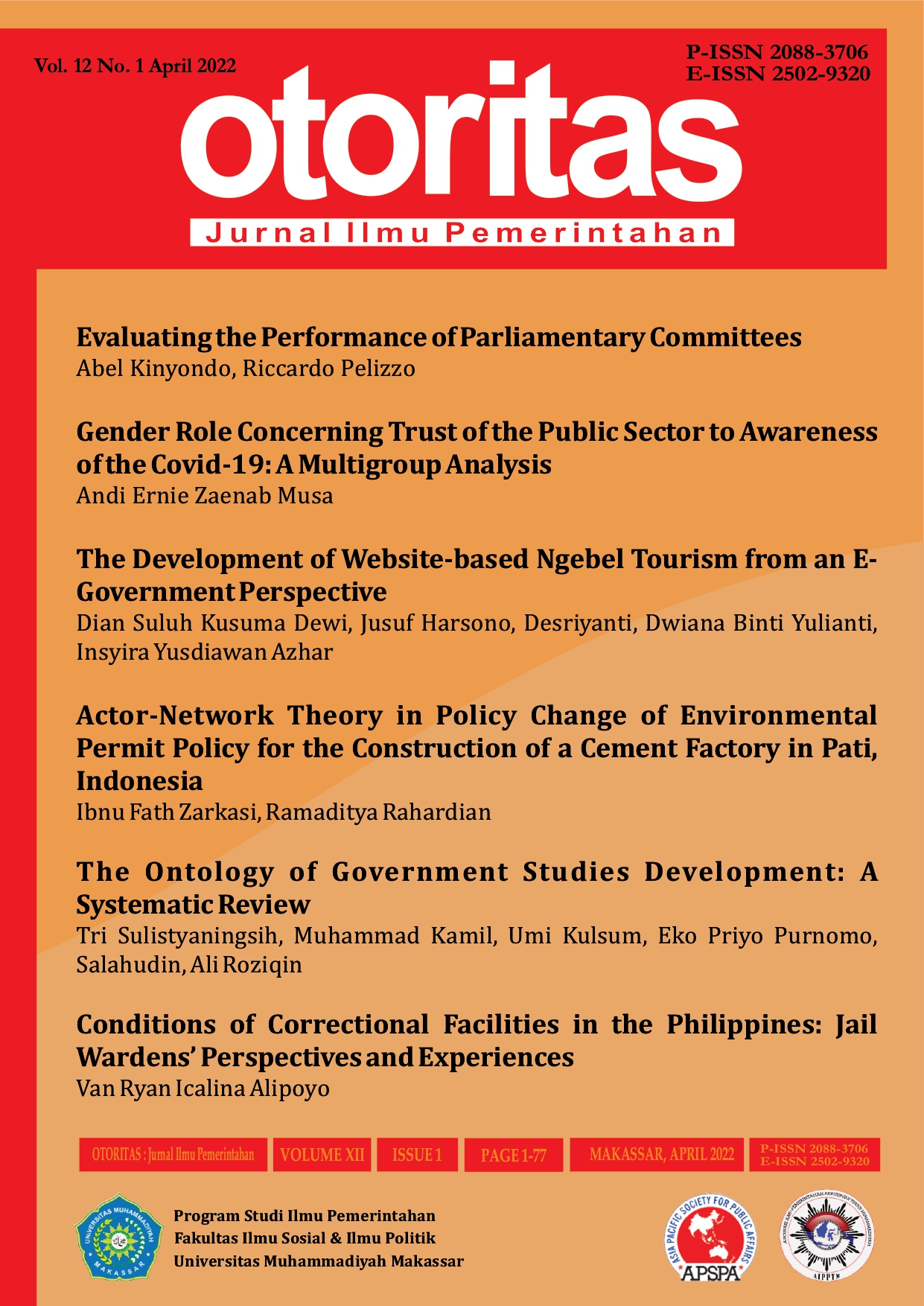Conditions of Correctional Facilities in the Philippines: Jail Wardens’ Perspectives and Experiences
DOI:
https://doi.org/10.26618/ojip.v12i1.6531Keywords:
Jail Wardens Experiences, Correctional Facility, Quality JailAbstract
The study explored the perspective and experiences of jail wardens in managing jail facilities in the Philippines for the calendar year 2019. A qualitative study with a transcendental phenomenological research design was used. The study focused on 10 jail wardens from correctional facilities in the provinces of Zamboanga del Norte and Zamboanga del Sur, Philippines. The themes reflect the participants' experiences on the conditions of correctional facilities and their viewpoint on quality correction such as erosion in conformity with the rules, scarcity of resources critical to jail services, the perils of poor staffing, freedom from congestion, infrastructure development, technology in correction, lifelong attempt for improvement and character development. This study concluded that the problems and challenges encountered by the correctional wardens in handling persons deprived of liberty (inmates) and in managing the jail facilities affected their roles and responsibilities in improving the conditions in the correctional facilities such as in the implementation of the reformation process of the PDLs, peace, and order within the facility, and in securing the safety of the personnel and the community. Thus, it is high time for the government and the legislative body of the Philippine government to improve the quality of correctional facilities, the following may be considered: the installation of high technology, construction of new and standard correctional facilities, and quick rehabilitation of old, outdated, or destroyed jails, allocation of budget or appropriations to enable the employment of more staff/personnel, and limiting the number of inmates in a prison cell.
References
Allard, T., Wortley, R., & Stewart, A. (2006). The Purposes of CCTV in Prison. Security Journal, 19(1), 58–70. https://doi.org/10.1057/Palgrave.sj.8350009
Atkin-Plunk, C. A., & Armstrong, G. S. (2013). Transformational Leadership Skills and Correlates of Prison Warden Job Stress. Criminal Justice and Behavior, 40(5), 551–568. https://doi.org/10.1177/0093854812460036
Bernard Nkala, & Phaello Olivia Malataliana. (2021). Examining factors that affect staff performance in Lesotho Correctional Service. World Journal of Advanced Research and Reviews, 9(3), 148–158. https://doi.org/10.30574/wjarr.2021.9.3.0087
De Guzman, A. B., Ibarrola, G. M. V., Idolog, C. L. J. I., & Ignacio, A. J. C. (2020). You can run but you can’t hide : a grounded theory analysis of suppression among older prisoners in the Philippines. Educational Gerontology, 46(5), 303–313. https://doi.org/10.1080/03601277.2020.1748798
Ellison, J. M., & Gainey, R. (2020). An opportunity model of safety risks among jail officers. Journal of Criminal Justice, 66, 101632. https://doi.org/10.1016/j.jcrimjus.2019.101632
Ferdik, F. V., & Smith, H. (2017). Correctional officer safety and wellness literature synthesis. Washington DC: National Institute of Justice.
Jones, C., Narag, R. E., & Morales, R. S. (2015). Philippine Prison Gangs: Control or Chaos? SSRN Electronic Journal, (71). https://doi.org/10.2139/ssrn.2586912
Jones, C. R., & Narag, R. E. (2021). Reducing the dangers of COVID-19 through shared governance in a Philippine jail. Current Issues in Criminal Justice, 33(1), 120–125. https://doi.org/10.1080/10345329.2021.1875566
Liebling, A., Johnsen, B., Schmidt, B. E., Rokkan, T., Beyens, K., Boone, M., … Vanhouche, A.-S. (2021). Where Two ‘Exceptional’ Prison Cultures Meet: Negotiating Order in a Transnational Prison. The British Journal of Criminology, 61(1), 41–60. https://doi.org/10.1093/bjc/azaa047
Lincoln, Y. S., Lynham, S. A., & Guba, E. G. (2011). Paradigmatic controversies, contradictions, and emerging confluences, revisited. The Sage Handbook of Qualitative Research, 4(2), 97–128.
MacDonald, M. (2018). Overcrowding and its impact on prison conditions and health. International Journal of Prisoner Health, 14(2), 65–68. https://doi.org/10.1108/IJPH-04-2018-0014
Molleman, T., & van der Broek, T. C. (2014). Understanding the links between perceived prison conditions and prison staff. International Journal of Law, Crime and Justice, 42(1), 33–53. https://doi.org/10.1016/j.ijlcj.2014.01.001
Mufarreh, A., Waitkus, J., & Booker, T. A. (2021). Prison official perceptions of technology in prison. Punishment & Society, 146247452199077. https://doi.org/10.1177/1462474521990777
Narag, R. E., & Jones, C. R. (2017). Understanding Prison Management in the Philippines. The Prison Journal, 97(1), 3–26. https://doi.org/10.1177/0032885516679366
Parsons, M. L., & Warner-Robbins, C. (2002). FACTORS THAT SUPPORT WOMEN’S SUCCESSFUL TRANSITION TO THE COMMUNITY FOLLOWING JAIL/PRISON. Health Care for Women International, 23(1), 6–18. https://doi.org/10.1080/073993302753428393
Patalinghug, M. E. (2021). The Life Changer: Social Workers in Rehabilitation Facilities for Child in Conflict with the Law. Otoritas : Jurnal Ilmu Pemerintahan, 11(1), 33–44. https://doi.org/10.26618/ojip.v11i1.5072
Pogrebin, M. (1982). Scarce Resources and Jail Management. International Journal of Offender Therapy and Comparative Criminology, 26(3), 263–274. https://doi.org/10.1177/0306624X8202600309
Reichstein, A. (2022). Relational dignity and assisted dying for persons deprived of liberty. International Journal of Prisoner Health. https://doi.org/10.1108/IJPH-07-2021-0067
Robinson, M. (2018). A Case Study of Overcrowding in a County Jail in the Southeast United States. Minneapolis: Walden University.
Ruddell, R., & Mays, G. L. (2007). Rural jails: Problematic inmates, overcrowded cells, and cash-strapped counties. Journal of Criminal Justice, 35(3), 251–260. https://doi.org/10.1016/j.jcrimjus.2007.03.002
St. John, V. J., Blount-Hill, K.-L., Evans, D., Ayers, D., & Allard, S. (2019). Architecture and Correctional Services: A Facilities Approach to Treatment. The Prison Journal, 99(6), 748–770. https://doi.org/10.1177/0032885519877402
Steiner, B., Butler, H. D., & Ellison, J. M. (2014). Causes and correlates of prison inmate misconduct: A systematic review of the evidence. Journal of Criminal Justice, 42(6), 462–470. https://doi.org/10.1016/j.jcrimjus.2014.08.001
Steiner, B., & Wooldredge, J. (2014). Comparing Self-Report to Official Measures of Inmate Misconduct. Justice Quarterly, 31(6), 1074–1101. https://doi.org/10.1080/07418825.2012.723031
Vachiradath, C. (2013). The Efficacy of Technology in Preventing the Escape of Inmates in Prison. Journal of Applied Security Research, 8(4), 477–489. https://doi.org/10.1080/19361610.2013.794407
Vickovic, S. G., & Morrow, W. J. (2020). Examining the Influence of Work–Family Conflict on Job Stress, Job Satisfaction, and Organizational Commitment Among Correctional Officers. Criminal Justice Review, 45(1), 5–25. https://doi.org/10.1177/0734016819863099
Western, B. (2021). Inside the Box: Safety, Health, and Isolation in Prison. Journal of Economic Perspectives, 35(4), 97–122. https://doi.org/10.1257/jep.35.4.97
Wood, S., Van Veldhoven, M., Croon, M., & de Menezes, L. M. (2012). Enriched job design, high involvement management and organizational performance: The mediating roles of job satisfaction and well-being. Human Relations, 65(4), 419–445. https://doi.org/10.1177/0018726711432476
Downloads
Published
Issue
Section
License
The Editorial Team of Otoritas: Jurnal Ilmu Pemerintahan reserves the right to transfer the copyright of the article once it has been accepted and a decision has been made to publish it.
Department of Government Studies, Faculty of Social and Political Sciences, Universitas Muhammadiyah Makassar in collaboration with Muhammadiyah’s College Association of Government Studies (AIPPTM) and Asia Pacific Society for Public Affairs (APSPA) as the publisher of Otoritas: Jurnal Ilmu Pemerintahan holds the copyright of all articles published in this journal.
The Publisher holds the right to reproduce and distribute the article and author is not allowed to publish the same article published in this journal.
Statement of Authenticity and Manuscript Copyright can be downloaded: here
After filling in the statement letter, please send via e-mail: otoritas@unismuh.ac.id






